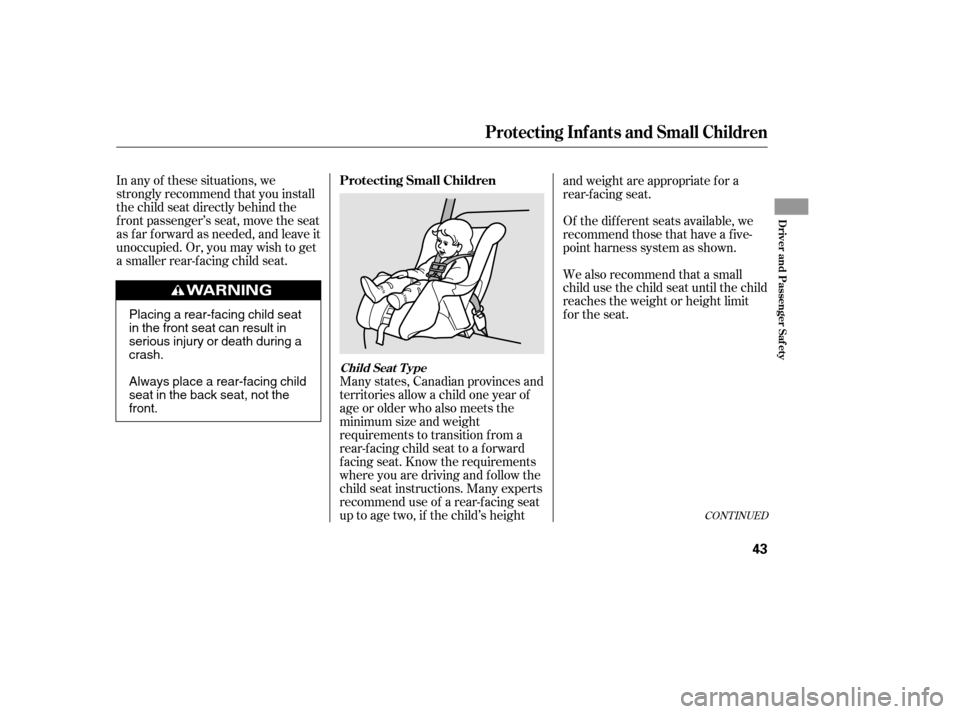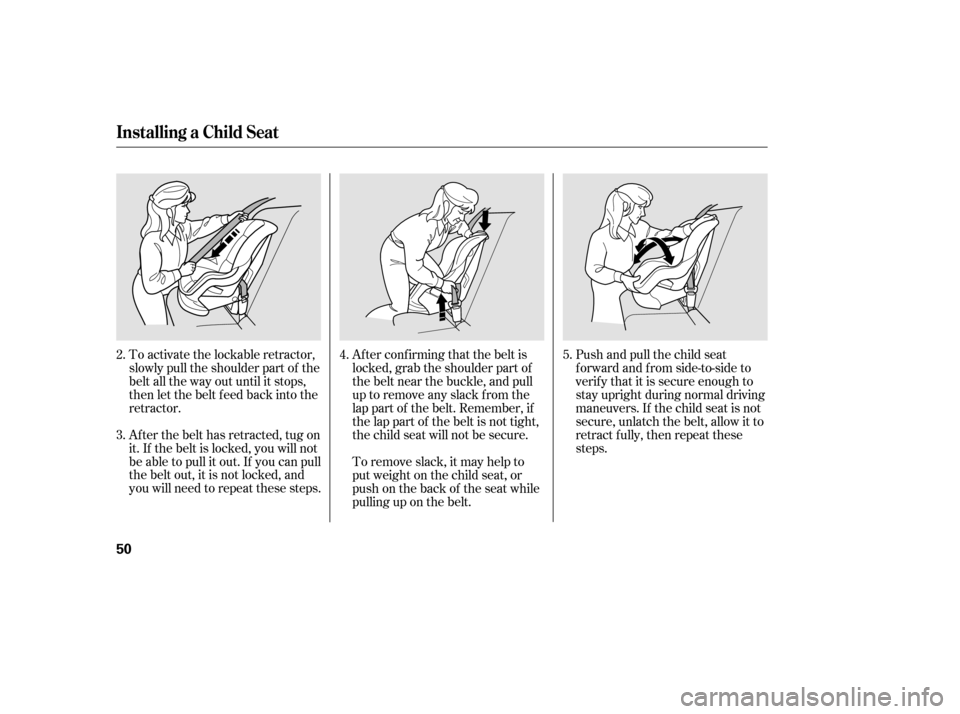Page 49 of 653

In any of these situations, we
strongly recommend that you install
the child seat directly behind the
f ront passenger’s seat, move the seat
as far forward as needed, and leave it
unoccupied. Or, you may wish to get
a smaller rear-f acing child seat.Many states, Canadian provinces and
territories allow a child one year of
age or older who also meets the
minimum size and weight
requirements to transition f rom a
rear-facing child seat to a forward
f acing seat. Know the requirements
where you are driving and follow the
child seat instructions. Many experts
recommend use of a rear-f acing seat
up to age two, if the child’s heightand weight are appropriate f or a
rear-facing seat.
Of the different seats available, we
recommend those that have a f ive-
point harness system as shown.
We also recommend that a small
child use the child seat until the child
reaches the weight or height limit
for the seat.
CONT INUED
Protecting Small Children
Child Seat T ype
Protecting Inf ants and Small Children
Driver and Passenger Saf ety
43
Placing a rear-facing child seat
in the front seat can result in
serious injury or death during a
crash.
Always place a rear-facing child
seat in the back seat, not the
front.
12/07/20 10:35:23 31TK4640_048
Page 51 of 653

Most child seats are LATCH-
compatible (Lower Anchors and
Tethers f or CHildren). Some have a
rigid-type connector, while others
have a f lexible-type connector. Both
are equally easy to use. Some
existing and previously owned child
seats can only be installed using the
seat belt. Whichever type you
choose, f ollow the child seat
manufacturer’s use and care
instructions as well as the
instructions in this manual. Proper
installation is key to maximizing your
child’s saf ety.In seating positions and vehicles not
equipped with LATCH, a LATCH-
compatible child seat can be installed
using the seat belt and a top tether
f or added security. This is because
all child seats are required to be
designed so that they can be secured
with a lap belt or the lap part of a
lap/shoulder belt.
In addition, the child seat
manufacturer may advise that a seat
belt be used to attach a LATCH-
compatible seat once a child reaches
a specif ied weight. Please read the
child seat owner’s manual f or proper
installation instructions.
The child seat is the correct type
and size f or the child.
The child seat is the correct type
f or the seating position.
The child seat is compliant with
Federal Motor Vehicle Saf ety
Standard 213 or Canadian Motor
Vehicle Saf ety Standard 213.
Make sure the child seat meets the
f ollowing three requirements:
Selecting a Child Seat
Important considerations when
selecting a child seat
Driver and Passenger Saf ety
45
12/07/20 10:35:34 31TK4640_050
Page 56 of 653

Af ter the belt has retracted, tug on
it. If the belt is locked, you will not
be able to pull it out. If you can pull
thebeltout,itisnotlocked,and
you will need to repeat these steps. To activate the lockable retractor,
slowly pull the shoulder part of the
belt all the way out until it stops,
then let the belt f eed back into the
retractor.To remove slack, it may help to
putweightonthechildseat,or
push on the back of the seat while
pulling up on the belt. Af ter conf irming that the belt is
locked, grab the shoulder part of
the belt near the buckle, and pull
up to remove any slack from the
lap part of the belt. Remember, if
the lap part of the belt is not tight,
the child seat will not be secure.Push and pull the child seat
f orward and f rom side-to-side to
verify that it is secure enough to
stay upright during normal driving
maneuvers. If the child seat is not
secure, unlatch the belt, allow it to
retract f ully, then repeat these
steps.
2.
3.
4. 5.
Installing a Child Seat
50
12/07/20 10:36:11 31TK4640_055
Page 59 of 653

To determine if a lap/shoulder belt
properly f its a child, have the child
put on the seat belt, then ask
yourself :Does the child sit all the way back
against the seat?
Do the child’s knees bend
comf ortably over the edge of the
seat?
When a child reaches the
recommended weight or height limit
for a forward-facing child seat, the
child should sit in a back seat on a
booster seat and wear the lap/
shoulder belt.
The f ollowing pages give
instructions on how to check proper
seat belt f it, what kind of booster
seat to use if one is needed, and
important precautions f or a child
who must sit in f ront.
1.
2.
CONT INUED
Checking Seat Belt Fit
Protecting L arger Children
Driver and Passenger Saf ety
53
Allowing a child age 12 or under
to sit in front can result in injury
or death if the passenger’s front
airbag inflates.
If a child must ride in front,
move the vehicle seat as far
back as possible, use a booster
seat if needed, have the child
sit up properly and wear the
seat belt properly.
12/07/20 10:36:33 31TK4640_058
Page 60 of 653

Does the shoulder belt cross
between the child’s neck and arm?
Is the lap part of the belt as low as
possible, touching the child’s
thighs?
Will the child be able to stay
seated like this f or the whole trip?
If you answer yes to all these
questions, the child is ready to wear
the lap/shoulder belt correctly. If
you answer no to any question, the
child needs to ride on a booster seat. A child who has outgrown a f orward- f acing child seat should ride in a
back seat and use a booster seat
until the lap/shoulder belt f its them
properly without the booster.Booster seats can be high-back or
low-back. Whichever style you select,
make sure the booster seat meets
f ederal saf ety standards (see page
) and that you f ollow the booster
seat maker’s instructions.
If a child who uses a booster seat
must ride in f ront, move the vehicle
seat as far back as possible and be
sure the child is wearing the seat
belt properly. Some states, Canadian provinces and
territories also require children to
use a booster seat until they reach a
given age or weight (e.g., 6 years or
60lbs).Besuretocheckcurrent
laws in the states, provinces or
territories where you intend to drive.
3.
4.
5.
45
Using a Booster Seat
Protecting L arger Children
54
12/07/20 10:36:40 31TK4640_059
Page 483 of 653

�µ�µ
�µ �µ
�µ
�µ
�µ
Aggressive driving (hard
acceleration and braking)
Excessive idling, accelerating and
braking in stop-and-go traf f ic
Cold engine operation (engines
aremoreefficientwhenwarmed
up)
Driving with a heavy load or the
air conditioner running
Improperly inf lated tires
The f ollowing f actors can lower your
vehicle’s f uel economy:
Rapid
acceleration, abrupt cornering,
and hard braking increase fuel
consumption.
Aerodynamic drag has a big ef f ect
on f uel economy at speeds above
45 mph (75 km/h). Reduce your
speed and you reduce the drag.
Trailers, car top carriers, roof
racks and bike racks are also big
contributors to increased drag.
If your vehicle has a
manual transmission, you can
boost your f uel economy by up
shif ting as early as possible.
Idling
results in 0 miles per gallon (0 kms
per liter).
It puts a heavier
load on the engine, increasing f uel
consumption.
In
particular, a build-up of snow or
mud on your vehicle’s underside
adds weight and rolling resistance.
Frequent cleaning helps your f uel
economy. An underinf lated tire increases
‘‘rolling resistance,’’ which reduces
f uel economy.
A properly maintained vehicle
maximizes f uel economy. Poor
maintenance can signif icantly reduce
f uel economy. Always maintain your
vehicle according to the maintenance
messages displayed on the multi-
inf ormation display (see on page ).
For example: 539
CONT INUED
Fuel Economy Factors
Use the recommended viscosity
motor oil, displaying the A PI
Certif ication Seal (see page ).
Improving Fuel Economy Drive moderately
Observe the speed limit
Always drive in the highest gear
possible
Avoid excessive idling
A void carrying excess weight in
your vehicle
K eep your vehicle clean Maintain proper tire inf lation
Owner’s
Maintenance Checks 543
Vehicle Maint enance
Drive Ef f icient ly
Fuel Economy
Bef ore Driving
477
12/07/20 11:32:01 31TK4640_482
Page 488 of 653

�µ�µ�·
Steps f or Determining Correct Load
Limit Locate the statement ‘‘The
combined weight of occupants and
cargo should never exceed XXX
kg or XXX lbs.’’ on your vehicle’s
placard.
Determine the combined weight
of the driver and passengers that
will be riding in your vehicle.
Subtract the combined weight of
the driver and passengers f rom
XXX kg or XXX lbs. The resulting f igure equals the
available amount of cargo and
luggage load capacity. For
example, if the ‘‘XXX’’ amount
equals 1,400 lbs. and there will be
f ive 150 lb. passengers in your
vehicle, the amount of available
cargo and luggage load capacity is
650 lbs.
(1,400 750 (5 150) = 650 lbs.)
Determine the combined weight
of luggage and cargo being loaded
on the vehicle. That weight may
not saf ely exceed the available
cargo and luggage load capacity
calculated in Step 4.
If your vehicle will be towing a
trailer, load f rom your trailer will
be transf erred to your vehicle.
Consult this manual to determine
how this reduces the available
cargo and luggage load capacity of
your vehicle.
The maximum load f or your vehicle
is 850 lbs (385 kg).
See Tire And Loading Inf ormation
label attached to the driver’s
doorjamb.
Label Example
This f igure includes the total weight
of all occupants, cargo, and
accessories, and the tongue load if
you are towing a trailer.
(1)
(2)
(3) (4)
(5)
(6)
Load Limits
Carrying Cargo
482
Overloading or improper
loading can affect handling and
stability and cause a crash in
which you can be hurt or killed.
Follow all load limits and other
loading guidelines in this
manual.
12/07/20 11:32:44 31TK4640_487
Page 489 of 653
In addition, the total weight of the
vehicle, all occupants, accessories,
cargo, and trailer tongue load must
not exceed the Gross Vehicle
Weight Rating (GVWR) or the Gross
Axle Weight Rating (GAWR). Both
areonalabelonthedriver’s
doorjamb.Store or secure all items that could
be thrown around and hurt
someone during a crash.
Do not put any items on top of the
trunk panel. They can block your
view and be thrown around the
vehicle during a crash.
Example 1
Example 2
Example 3
CONT INUED
Carrying Cargo in the Passenger
Compartment
Carrying Cargo
Bef ore Driving
483
Passenger Weight
150 lbs x 2 = 300 lbs
(68kgx2=136kg)
Passenger Weight
150 lbs x 4 = 600 lbs
(68kgx4=272kg)
Passenger Weight
150 lbs x 5 = 750 lbs
(68kgx5=340kg)
Max Load 850 lbs
(385 kg)
Max Load 850 lbs (385 kg)
Max Load 850 lbs (385 kg) Cargo Weight
550 lbs
(249 kg)
Cargo Weight
250 lbs
(113 kg)
Cargo Weight
100 lbs
(45 kg)
12/07/20 11:32:57 31TK4640_488